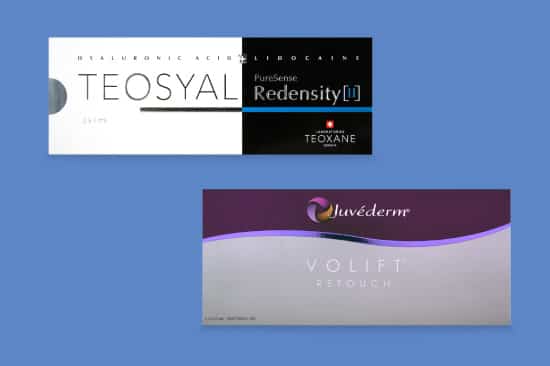Juvederm is a brand of premier hyaluronic acid-based aesthetic fillers that are manufactured by Allergan. This brands products are designed to add volume, eliminate wrinkles, and rejuvenate aging adult skin in specific areas of the face. As each filler in this brand is intended to treat indications in dermal depths specific to it, the concentration and particle sizes of their hyaluronic acid content are adjusted accordingly. This includes products that treat forehead and glabellar lines, nasolabial and marionette folds, the vermillion border of the lips, and the tear troughs.
The Teosyal brand is a product of Teoxane, a Swiss manufacturer. This brand comprises hyaluronic acid-based dermal fillers that address concerns ranging from superficial skin rejuvenation to cheek and chin augmentation. Compared to Juvederm, Teosyal has a larger range of products to choose from.
Similarities
Juvederm fillers are clear, colorless, nonpyrogenic, cohesive and processed with either Hylacross? or Vycross technology. Instead of being sourced from a mammalian origin, the hyaluronic acid (HA) molecules used in Juvederm fillers are extracted via bacterial fermentation. In some formulations, the linear hyaluronic acid molecules are processed via Hylacross technology, resulting in a homologous concentration that is subsequently cross-linked with BDDE, a reticulating agent. This process creates longer-lasting gels that resist degeneration upon implantation.
Vycross technology creates fillers that are 10% high-molecular-weight HA and 90% of low-molecular-weight HA; this make-up adds strength and lifting capacity. As a result, Vycross products such as Volbella and Voluma are apt for lip and cheek augmentation.
Similar to Juvederm, the monophasic HA in Teosyal fillers is sourced from bacterial fermentation and has been cross-linked for added strength. However, some products contain additional substances. The Redensity line of fillers contains additional amino acids, antioxidants, and vitamin B6 nutrients that provide skin cell regeneration and protection. The fillers in Teosyal’s Resilient HA (RHA) line have different cross-linking rates, from 1.9% to 4.0%, as a means of maintaining dynamic facial movement after implantation.
Hyaluronic acid is a resorbable substance and, as such, the results of dermal fillers are temporary. Juvederm and Teosyal fillers share many similarities when it comes to their endurance, with impressive results lasting from six to 18 months, depending on the filler used. Results from either brand can be maintained through repeat treatments at the 9th or 12th month.
Differences
Unlike other fillers on the market, the differences between Teosyal and Juvederm are really few and far between. While they are of course produced by different manufacturers using uniquely developed technologies, the remaining differences are very few. Doctors and clients may prefer one of these brands over the other when treating a specific area, which is simply personal preference.
Conclusion
Ultimately, dermal filler treatment requires clear communication regarding outcomes, pain threshold, management and aftercare. When treating various areas of the face, including the eyes, lips, cheeks and nose, Juvederm and Teosyal fillers are similar brands that result in youthful and radiant skin.





















